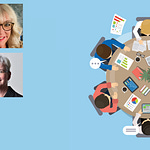Turning warm supporters into Legacy supporters
In this episode, we looked at the ideas and strategies for turning warm supporters into legacy supporters. Below is a summary of some of the key thoughts from our guests.
Jenny Kronbergs (Head of Gifts in Wills, UNICEF UK)
Jenny co-hosted the episode with Alexis Kreager, and shared valuable insights into her experience in the legacy sector, the importance of warm audiences, and why talking to warm supporters should be a core pillar of any legacy strategy. One of the biggest hurdles in legacy giving is getting your audience interested in your cause and gaining their trust for your charity – with warm supporters, these hurdles are already overcome.
She encouraged legacy teams to take the supporter’s viewpoint into consideration as often they see legacy giving as a natural progression of their lifetime support towards a charity. Jenny mentioned that someone who receives communications from a charity asking for legacy gifts is 17 times more likely to leave one than someone who has not been asked. This came from a Dame Greene study* and shows how crucial it is that sharing legacy messaging with warm supporters is prioritised as part of every legacy strategy.
Jenny shared UNICEF UK’s focus on legacy activity, including working with internal comms to talk to other teams about how important it is to communicate the legacy message to their supporters. She talked about the challenges around cross-selling and the fear among fundraising colleagues that supporters would stop their regular giving. However, according to a Russell James study*, the the lifetime giving for supporters goes up by 77% after they’ve made the decision to leave a legacy gift.
Richard Hill (Development Manager, Legacy Foresight)
Our discussion with Richard was based around insights from the Legacy Inspire project*, which had been conducted at Legacy Foresight. The project involved mystery shopping the top 100 legacy charities in January, looking at timing and accuracy, as well as quality of communication. The main aim of the project was to shine a spotlight on really great examples of legacy communications and inspire other organisations to improve their communications. As part of this project, they developed key elements on which the scoring was based, called the 5 I’s:
Implementation
Impact
Inspiration
Integrity
Information
Together, all these elements help make an effective legacy communication which will leave a lasting impression on your supporters. Richard explains how a GiW pack can offer big opportunities for warm audience conversion and gave suggestions for maximising the value of a pack for warmer audiences. A couple of the top tips he shared included ensuring the pack is sent out promptly after enquiry and to capture the reader’s attention with envelope by using something like a handwritten address or imagery.
Alexis Fairclough (Head of Regional Development , Bequeathed)
Alexis has been working in the fundraising sector for the past few decades and joined us to discuss free will schemes. She explained that the first hurdle in legacy giving is getting supporters to write their will and barriers to this are price, convenience and reassurance. A free, trustworthy online will service can help remove these barriers – especially as in the current environment, people may not feel comfortable physically going to a law firm.
She shared some case studies showing the impact of using a free will service. One charity with 9,000 employees sent an all-staff email to promote their service with a legacy ask. Through this, they were able to uncover 50 new pledgers amongst the staff and 5 of these were residuary gifts. Alexis also discussed engaging with a wider audience such as existing corporate partners, who can offer their employees a free will. She encouraged anyone looking into a free wills service to do their homework and make sure their chosen provider is able to support them in the way that best suits their needs.
Helen Smith (Senior Legacy Engagement Manager, Cancer Research UK)
Helen joined the panel for this episode, with an insightful discussion around audiences we should be approaching and talking to. She talks about thinking of legacies as a “destination” and that all supporters should be aware that they can leave a gift, although we need to acknowledge not everyone will. It’s important that all staff in your charity understand the longevity of legacy gifts and your supporters should be the last to know that you’re implementing a legacy strategy.
She talked about the wealth of supporters we have across the board, including huge audiences such as volunteers, especially in trading. She explained why we need to make sure shop staff and volunteers understand how vital legacy giving is to a charity and we should always celebrate any success they bring for the charity. Helen also discussed the increase seen in legacy pledges from the lottery audience recently, which is catching up with the regular giving audience. There’s also a younger cohort who have come through digital advertisement on social media.
Helen reminded us that people will only give if they’re asked and that they need between 11 to 13 meaningful touchpoints with charities to consider leaving a legacy gift. It’s vital to have a supporter-centric attitude and make sure that legacy is in every communication, letting people know how much you’re funded by legacies. She also discussed how to build cross-selling into your strategy, starting with your closest supporters and looking at loyalty and frequency over value of gifts.
References
Dame Greene Study: https://legacyvoice.co.uk/wp-content/uploads/2018/05/Legacy-Voice-lit-review_full-report_03.pdf
Russell James Study: https://lawreview.law.ucdavis.edu/issues/53/5/symposium/files/53-5_James.pdf
Legacy Inspire Report: https://legacyvoice.co.uk/legacy-inspire-communications/












Share this post